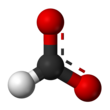
| |||
| |||
| Names | |||
|---|---|---|---|
| Preferred IUPAC name
Potassium formate | |||
| Identifiers | |||
3D model (JSmol)
|
|||
| ChemSpider | |||
| ECHA InfoCard | 100.008.799 | ||
PubChem CID
|
|||
| UNII | |||
CompTox Dashboard (EPA)
|
|||
| |||
| |||
| Properties | |||
| CHKO2 | |||
| Molar mass | 84.115 g·mol−1 | ||
| Appearance | Colorless deliquescent crystals | ||
| Density | 1.908 g/cm3 | ||
| Melting point | 167.5 °C (333.5 °F; 440.6 K) | ||
| Boiling point | Decomposes | ||
| 32.8 g/100 mL (0 °C) 331 g/100 mL (25°C) 657 g/100 mL (80 °C) | |||
| Solubility | soluble in alcohol insoluble in ether | ||
| Basicity (pKb) | 10.25 | ||
| Hazards | |||
| GHS labelling: | |||

| |||
| Warning | |||
| H315, H319, H335 | |||
| P261, P280, P302+P352, P305+P351+P338 | |||
| Lethal dose or concentration (LD, LC): | |||
LD50 (median dose)
|
5500 mg/kg (oral, mouse) | ||
Except where otherwise noted, data are given for materials in their standard state (at 25 °C [77 °F], 100 kPa).
| |||
Potassium formate, HCO2K, HCOOK, or KHCO2, is the potassium salt of formic acid. This strongly hygroscopic white solid[2] is an intermediate in the formate potash process for the production of potassium.[3] Potassium formate has also been studied as a potential environmentally friendly deicing salt for use on roads.[4][5] It has also been suggested for use in a less corrosive liquid desiccant.[6] A 52% solution of potassium formate has a freezing point of −60 °C (−76 °F).[7] Potassium formate brines are sometimes used for heat transfer, despite being much more corrosive than many other liquid coolants, especially to zinc and aluminum but even to many steels,[8] though some formulations are compatible with aluminum and steels.[9]
References[edit]
- ^ Olsen, J C (editor), Van Nostrand's Chemical Annual, Chapman and Hall, London, 1934
- ^ "MSDS - 294454". www.sigmaaldrich.com. Retrieved 2019-03-18.
- ^ Concise Encyclopedia Chemistry, Mary Eagleson (1994), page 888. ISBN 978-3-11-011451-5
- ^ "Finnish Environment Institute > Main publications on the effect of de-icing chemicals on ground water". www.syke.fi. Retrieved 2015-11-18.
- ^ Pasi P. Hellstén; Jani M. Salminen; Kirsten S. Jørgensen & Taina H. Nystén (2005). "Use of potassium formate in road winter deicing can reduce groundwater deterioration". Environ. Sci. Technol. 39 (13): 5095–5100. Bibcode:2005EnST...39.5095H. doi:10.1021/es0482738. PMID 16053115.
- ^ "Module 71: Liquid desiccants for dehumidification in building air conditioning systems".
- ^ "Potassium Formate for Runway Deicing".
- ^ "Brines and antifreeze". Retrieved 2022-01-16.
- ^ "Technical information on "TYFOXIT F15-F50: Ready-to-Use, High-Performance Ultra Low Viscous Secondary Refrigerants for Applications Down to –50 °C"" (PDF). Retrieved 2022-01-16.

